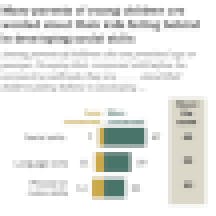There is a notable gulf between parents of K-12 students who are attending school in person this fall, and those whose children are getting some or all of their instruction virtually, according to the results of a survey conducted by Pew Research Center in mid-October.
Ninety percent of parents whose children are back in school full-time say they are “somewhat” or “very” satisfied with their schools’ handling of reopening, and are significantly less concerned about their children falling behind academically due to disruptions and closures caused by the pandemic.
For parents whose children receive at least some of their instruction online, that satisfaction dips to 76 percent. In addition, about 32 percent of them say they are “very concerned” about their kids falling behind in school, and another 36 percent are “somewhat concerned.” Comparatively, only 21 percent of parents whose children are back in school say they are “very concerned,” and 34 percent are “somewhat concerned.”

The apparent upside for parents of students who are still learning at home is that their children are at a much lower risk of contracting COVID-19 and spreading it to more vulnerable members of the family and community. Yet, according to the Pew survey, which is nationally representative and includes the perspectives of 2,561 U.S. parents, 85 percent of parents whose children are getting in-person instruction say they are “somewhat” or “very” satisfied with their school’s safety protocols to prevent a COVID-19 outbreak.
Of the parents surveyed by Pew, 20 percent say their children are attending school in person all the time, 46 percent say their children are receiving full-time remote learning, and 23 percent of parents say their children’s schools are using a hybrid approach.
Notably, said Ruth Igielnik, senior researcher at Pew and co-author of the report, another 7 percent of parents say they are homeschooling their children this fall, up from 3 percent in April. That marks a statistically significant change in just six months, Igielnik said. The remaining 4 percent of respondents said their children are doing some combination of those approaches.
Broken down by socioeconomic levels, lower-income families are most concerned (72 percent) about their children falling behind in school, compared with upper-income (55 percent) and middle-income (63 percent) families.
The Pew survey also found that nearly one in five upper-income families have hired someone to help their children with instruction, compared to 7 percent of middle income and 8 percent of low income families. “That is a huge difference by family income,” Igielnik said. “There’s this big inequity.”
Over the summer, when schools and districts began to release reopening plans that families found less than palatable, many parents—in closed Facebook groups, email chains and group messages—began formulating plans to hire private educators to teach their students in “learning pods.” Critics of the plans said it would exacerbate inequities in education, since many families cannot afford private tutors. The Pew results indicate that upper income-families moved forward with these plans, and that those concerns were warranted.
Among the parents of K-12 students who fear their children will fall behind, a top concern is that their children are getting too much screen time, followed by a lack of social connections and friendships during the pandemic—all taking a toll on their social-emotional well being. Parents also worry their children do not have access to extracurricular activities and are not getting enough exercise.

For parents of young children who are not old enough for kindergarten, they worry most that their children’s social skills will be stunted, followed by worries about underdeveloped language and motor skills.


